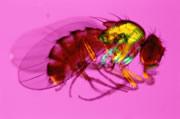 Funny gene names are fine for fruitflies, but not for humans.Getty
Funny gene names are fine for fruitflies, but not for humans.Getty"How would you feel if you were telling a patient they had lunatic fringe mutation?" asks Sue Povey, who chairs the Human Genome Organisation (HUGO) Gene Nomenclature Committee. It's a rhetorical question: the answer is that no one should have to make such an announcement. And Povey's committee is renaming a number of genes that have potentially offensive or embarrassing names so that in the future no one will.
The shortlist of 10 genes — including radical fringe, lunatic fringe and, bizarrely, Indian hedgehog — was compiled in response to physicians' worries about "inappropriate, demeaning and pejorative" names. The committee consulted more than a hundred geneticists via its website, to gather advice on what to do about the nomenclature.
The problem arose because most of the genes were initially discovered in fruitflies, and their names were then transferred to the human versions of the genes, which were discovered later. "The fruitfly community is not necessarily anarchic but they do have wild ideas about gene names," says Povey. The video-game-inspired sonic hedgehog is perhaps the most noted example of such wildness.
Online consultation
“The fruitfly community is ïnot necessarily anarchic but they do have wild ideas about gene names.”
Sue Povey,
HUGO Gene Nomenclature Committee
But when applied to the human versions of the genes, many of these names become uncomfortable, says Mark Ludman, a medical geneticist at Dalhousie University in Halifax, Canada, who studies the skeletal-development defect caused by defects in the human version of lunatic fringe.
"It struck me that if I were talking to a patient and telling them the problem is that they have a mutation in their lunatic fringe, that would be an inappropriate conversation we were having," he says.
Ludman and several of his colleagues therefore appealed to the HUGO committee to launch the consultation that led to the drawing up of the short-list. Povey says the resulting response was the largest for any online consultation run by the committee.
"Some people said patients should just be able to deal with it," says Povey. But the majority voted that the genes should now be known simply by their abbreviations — turning lunatic fringe into LFNG. The revised nomenclature will now be posted to the various gene databases that rely on the committee for up-to-date adjudications on the official naming of genes. "Gene names do get changed quite a lot," says Povey, so it's important for there to be an overall authority on the naming process.
No joke
While no one wants to curtail the creativity of fruitfly geneticists, it will be important to ensure that, in the future, no joky names are adopted for human genes where they might cause offence, Ludman adds. Other quirky names in the fruitfly genome include headcase and mothers against decapentaplegia (MAD).
ADVERTISEMENT
The HUGO committee's move should help gene names to catch up with other areas of medical terminology in the sensitivity stakes, Ludman says. "We don't use terms like gargoylism or mongoloidism any more, and yet we still have these gene names like lunatic that are quite fanciful," he says. "That's playful and fine for scientists, but for human applications it's quite uncomfortable to be using these terms."
Visit our genenamesgetthe.html">newsblog to read and post comments about this story.
HUGO Gene Nomenclature Committee
